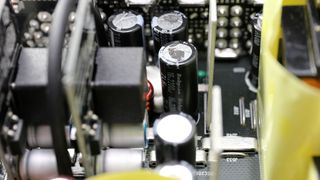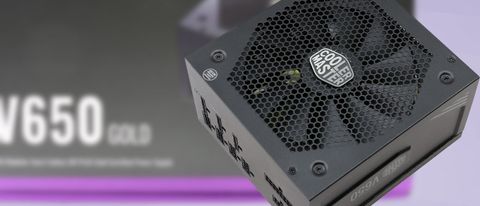Tom's Hardware Verdict
The V650 has high build quality and satisfactory overall performance, but with the same or a lower amount, you can find better options.
Pros
- +
Full power at 47 degrees Celsius
- +
High build quality
- +
Quiet operation
- +
Long hold-up time
- +
10-year warranty
- +
2x EPS and 4x PCIe connectors
- +
Fully modular
Cons
- -
Expensive
- -
No MOV and NTC thermistor
- -
Mediocre EMC performance
- -
Average transient response
- -
Small distance between peripheral connectors
Why you can trust Tom's Hardware
The Cooler Master V650 Gold features good build quality, but this is not enough to beat the competition, especially since its price is stiff and availability, in the US market at least, is limited. With the same or even lower amount, someone can get better power supplies from Corsair (RM650x), Seasonic (Focus Plus Gold 650W), EVGA (SuperNOVA 650 G3), and Asus (Rog Strix 650).
Cooler Master's V Gold line consists of four models, with capacities ranging from 550W to 850W. We have already evaluated the 750W unit (V750 Gold), and in this review, we will take a detailed look at the 650W model, which has enough power to handle a mid-level system.
The V650 Gold (model number: MPY-6501-AFAAGV), like all the other members of the family, is fully modular and is equipped with a 135mm fluid dynamic bearing fan, which is supported by a semi-passive mode that can be deactivated, should you want the fan to be always spinning. Another interesting note about the V650 Gold is that it uses 16AWG gauges for the PCIe connectors, despite its modest capacity. Nonetheless, our sample came with standard 18AWG gauges, but according to Cooler Master, this won't be the case with retail units.

Product Photos








The V650 Gold is 80 PLUS certified, and it has also been evaluated by Cybenetics, scoring ETA-A and LAMBDA-A-, efficiency, and noise levels, respectively. This is not the quietest 650W power supply that money can buy today, but it is quiet enough with less than 30 dB(A) overall noise output.

Product Photos






Specifications
|
Manufacturer (OEM) |
Chicony Electronics |
|
Max. DC Output |
650W |
|
Efficiency |
80 PLUS Gold, ETA-A (88-91%) |
|
Noise |
LAMBDA-A- (25-30 dB[A]) |
|
Modular |
✓ (Fully) |
|
Intel C6/C7 Power State Support |
✓ |
|
Operating Temperature (Continuous Full Load) |
0 - 50°C |
|
Over Voltage Protection |
✓ |
|
Under Voltage Protection |
✓ |
|
Over Power Protection |
✓ |
|
Over Current (+12V) Protection |
✓ |
|
Over Temperature Protection |
✓ |
|
Short Circuit Protection |
✓ |
|
Surge Protection | ✗ |
|
Inrush Current Protection | ✗ |
|
Fan Failure Protection |
✗ |
|
No Load Operation |
✓ |
|
Cooling |
135mm Fluid Dynamic Bearing Fan (SAC4H2H) |
|
Semi-Passive Operation |
✓ (selectable) |
|
Dimensions (W x H x D) |
152 x 87 x 162mm |
|
Weight |
1.46 kg (3.22 lb) |
|
Form Factor |
ATX12V v2.4, EPS 2.92 |
|
Warranty |
10 Years |
Power Specifications
| Rail | 3.3V | 5V | 12V | 5VSB | -12V | |
|---|---|---|---|---|---|---|
| Max. Power | Amps | 20 | 20 | 54 | 3 | 0.3 |
| Watts | 130 | 648 | 15 | 3.6 | ||
| Total Max. Power (W) | 650 |
Cables & Connectors
| Modular Cables | Cable Count | Connector Count (Total) | Gauge | In Cable Capacitors |
|---|---|---|---|---|
| ATX connector 20+4 pin (650mm) | 1 | 1 | 18-22AWG | No |
| 4+4 pin EPS12V (650mm) | 1 | 1 | 18AWG | No |
| 8 pin EPS12V (650mm) | 1 | 1 | 18AWG | No |
| 6+2 pin PCIe (550mm+120mm) | 2 | 4 | 18AWG | No |
| SATA (500mm+120mm+120mm+120mm) | 2 | 8 | 18AWG | No |
| 4 pin Molex (500mm+120mm+120mm+120mm) | 1 | 4 | 18AWG | No |
| FDD Adapter (125mm) | 1 | 1 | 22AWG | No |
| AC Power Cord (1350mm) - C13 coupler | 1 | 1 | 18AWG | - |
Although it is a mid-capacity unit, the V650 Gold has plenty of connectors, including a pair of EPS and four PCIe. The number of peripheral connectors is also high, but the distance between them is small at only 120mm. Finally, there are no in-cable caps in any of the cables, which is an asset for cable management and routing processes.

Cable Photos







Component Analysis
We strongly encourage you to have a look at our PSUs 101 article, which provides valuable information about PSUs and their operation, allowing you to better understand the components we're about to discuss.
| General Data | - |
| Manufacturer (OEM) | Chicony Electronics |
| PCB Type | Single Sided |
| Primary Side | - |
| Transient Filter | 4x Y caps, 2x X caps, 2x CM chokes |
| Inrush Protection | - |
| Bridge Rectifier(s) | 2x GBU15JL (600V, 15A @ 115°C) |
| APFC MOSFETS | 1x Infineon IPW60R099P6 (650V, 24A @ 100°C, 0.099Ohm) |
| APFC Boost Diode | 1x CREE C3D06060A (600V, 6A @ 154°C) |
| Hold-up Cap(s) | 1x Nichicon (450V, 560uF, 2,000h @ 105°C, GL) |
| Main Switchers | 2x Infineon IPA60R099P6 (650V, 24A @ 100°C, 0.099Ohm) |
| APFC Controller | Infineon ICE3PCS03G |
| Resonant Controllers | MPS HR1000A & 2x MPS MP6903 (Installed on the secondary side) |
| Topology | Primary side: Half Bridge & LLC resonant converter Secondary side: Synchronous Rectification & DC-DC converters |
| Secondary Side | - |
| +12V MOSFETS | 4x JA54 |
| 5V & 3.3V | DC-DC Converters: 2x Infineon IPD040N03L (30V, 76A @ 100°C, 4mOhm) & 4 Alpha & Omega D528 PWM Controllers: 2x APEC APW7160A |
| Filtering Capacitors |
Electrolytics: 6x Rubycon (6-10,000h @ 105°C, ZLH), 1x Nichicon (5-6,000h @ 105°C, HV), 1x Nippon Chemi-Con (5-6,000h @ 105°C, KZH), 1x Nippon Chemi-Con (4-10,000h @ 105°C, KY) |
| Supervisor IC | CP006WD |
| Fan Model | Apistek SAC4H2H (135mm, 12V, 0.5A, Fluid Dynamic Bearing Fan) |
| 5VSB Circuit | - |
| Rectifier | 1x Diodes Inc. SDT20100CT TSR (100V, 20A) & 1x Alpha & Omega AOTF3N80 FET (800V, 1.8A @ 100°C, 4.8Ohm) |
| Standby PWM Controller | 400BBBBB2 PAJH |
| -12V | - |
| Rectifier | UTC LM7912L (-12V, 1A) |

Overall Photos



The platform's design looks clean, with adequate distance between the components for proper airflow. The primary heatsink is small, given that it hosts both the APFC converter's parts and the primary FETs. On the secondary side, the heat sinks are even smaller, since the +12V FETs are installed on the solder side of the main PCB.
On the primary side, a half-bridge topology is utilized along with an LLC resonant converter. On the secondary side, we find a synchronous regulation scheme along with a pair of DC-DC converters, for the generation of the minor rails. Finally, the assembly and soldering quality are good, and the parts that Chicony used belong to good lines, especially the capacitors.

Transient filter



The transient filter doesn't include an MOV, unfortunately. This inexpensive part provides protection against voltage surges and spikes, coming from the network, so it is crucial and this is why most PSUs include one.

Bridge rectifiers

Both bridge rectifiers are bolted onto a small heat sink.

APFC converter




The APFC converter uses quality parts, including a Nichicon bulk cap, with enough capacity to provide a longer than 17ms hold-up time.

Main FETs and primary transformer



The main switching FETs, two Infineons, are configured in a half-bridge topology. An LLC resonant is also used to lower the switching losses.

12V FETs and VRMs




The +12V FETs are installed on the back side of the main PCB. The same rail feeds a pair of VRMs, which generate the minor rails (5V and 3.3V).

All filtering caps belong to good lines of Japanese manufacturers. Besides electrolytic caps, Chicony also used enough polymer ones, which are much more tolerant of increased operating temperatures.

Modular board front


The modular board hosts many polymer caps. The power transfers are conducted through bus-bars, for reduced energy consumption.

5VSB Circuit


The 5VSB regulator uses an Alpha & Omega FET on its primary side and a TSR (Trench Schottky Rectifier) on its secondary side. The latter part briefly is an upgraded SBR (Schottky Barrier Diode), with lower energy losses and excellent EMC performance.

Supervisor IC

The supervisor IC is a CP006WD. We couldn't find any information on this IC, to check on the protection features that it supports.

Soldering quality




The soldering quality is good. Moreover, on this side of the PCB, there are many interesting parts, including the +12V FETs, the APFC, resonant and standby controllers, and the pair of MPS MP6903 low-drop diode emulators.

Cooling fan

The cooling fan is provided by Apistech and uses a fluid dynamic bearing. We don't have much information on the reliability of those fans, so only time will tell whether they are up to the task in a PSU that is covered by a ten-year warranty.
MORE: Best Power Supplies
MORE: How We Test Power Supplies
MORE: All Power Supply Content
Current page: Specifications and Part Analysis
Next Page Load Regulation, Hold-Up Time, Inrush Current, Efficiency and NoiseAris Mpitziopoulos is a Contributing Editor at Tom's Hardware US, covering PSUs.

Nvidia Blackwell and GeForce RTX 50-Series GPUs: Rumors, specifications, release dates, pricing, and everything we know

HyperX Alloy Rise Mechanical Gaming Keyboard Review: Magnetic Customization… at a Price

Qualcomm teases Snapdragon X with no mention of Elite — news of second chip could be coming on April 24
